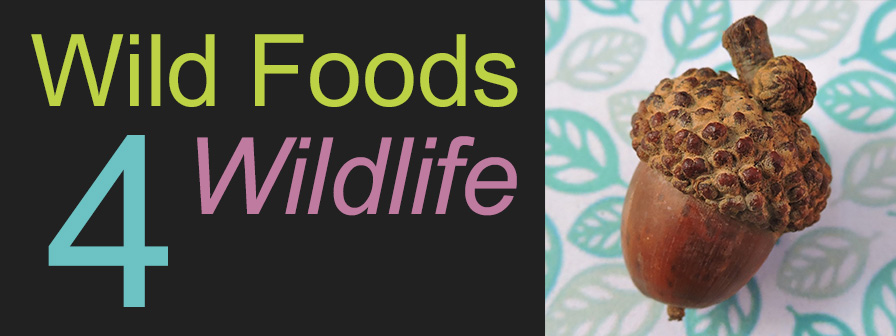Name: Bristlegrass, Nodding
Botanical Name: Setaria faberi
Form: grass
Parts Used: seeds, greens
Citation: Guenther, K. (2017, January 12) Bristlegrass as wildlife food [Web log post.] Retrieved: readers supply the date cited, from http://wildfoods4wildlife.com
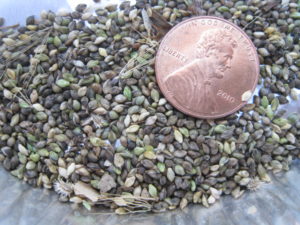
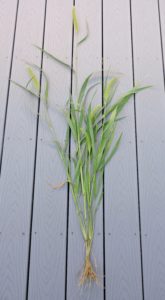
Getting Started
Bristlegrass species ranks whopping #3 on our Super Seeds List! So this is a really good easily-collected seed that anyone can get started with.
Bristlegrasses are one of a number of genera that are often referred to as a “wild millet”. “Millet” is a generalized term that can refer to any number of small grass seeds. And though sometimes listed as “wild millets” nearly all of them are cultivated, and many are non-natives (Elpel, 2013). Read more about the confusing millet genera under the tab “Confusing Genera.”
Regarding grass-like plants, many of you have likely memorized this helpful identification rhyme:
“Sedges have edges,
Rushes are round,
Grasses have knees where the leaves are found!”
(Or, alternately, “Grasses are hollow, what have you found?”)
Like most grasses, the bristlegrass stem will be hollow when you break it open. Also, the stem swells out to appear as if it has knees—botanically referred to as nodes— at the point on the stem where the leaf attaches.
Poaceae (Grass Family)
Setaria ( Bristlegrass or Foxtail Genus)
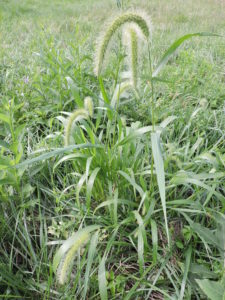
| Common name | Virginia Setaria Species | Origins | Rare Plant Status |
| nodding bristlegrass | S. faberi | non-native | not rare |
| fox-tail millet | S. italic | non-native | not rare |
| giant bristlegrass | S. magna | native | not rare |
| knotroot bristlegrass | S. parvifloraa | native | yes, in some states (not Virginia) |
| yellow bristlegrass | S. pumila | non-native | not rare |
| hooked bristlegrass | S. verticillata | non-native | not rare |
| green bristlegrass | S. viridis | non-native | not rare |

Key Features to Look For
In addition to the identification guide of your choice, here are a couple of features you should see on this grass:
- 2-4 foot stem, multiple stems per plant
- arching foxtail seed head structure, 3 to 6 inches long at top of stem
- mat of many fibrous roots
- “knees” where the leaves attach, and hollow stems
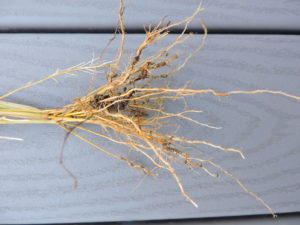
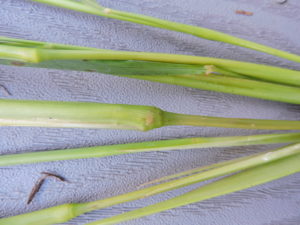
Risks
No risks known for cleaned seed, but the awns or “bristles” on the seed head can sometimes poke into the mouth tissues and cause some mechanical damage to the mouth. One or more Setaria spp. has been toxic to horses and can create primary photosensitivity.(Burrows, G.E. & Tyrl, R.J., 2013)
About this Species
There are a mind-bewildering number of types of grasses. Bristlegrass is my “go-to” grass seed because 1) its “foxtail” shaped seed head makes it easily identifiable 2) it is common and plentiful 2) it is a popular wildlife seed. Easy peasy! You can’t say that about all grass identification, which is considered pretty hard for budding botanists, including me.
Look for bristlegrass at the edges of fields, old pastures, anywhere soil has been disturbed. You’ll find it roadside, but beware of collecting seed where toxic car fumes have repeatedly coated the plants.
Flower Description: Grasses differ somewhat in anatomy and botanical terms from wildflowers. For our purposes, let’s try to keep it simple. On top of a 2-4 foot stem is an arching foxtail or bottlebrush-looking structure—a spike-like panicle. When you touch the foxtail, your hand first encounters the ends of the bristles that stick out from and protect the flowers (or seeds depending on the maturity if the plant). Since grasses rely on wind to pollinate them, they do not have colorful, petal flowers to attract birds and insects. But they do have flowers— just tiny, inconspicuous ones hidden by the bristles. When young, the bristles are light green and turn to beige as they mature. Up to 6 bristles are grouped together to form a spiklet of one flower that matures into one seed
The whole arching “foxtail” structure itself is between 2.5- 4 inches (6-10 cm) long and the bristles that stick out like a bottlebrush are about 5/8 inch (15 mm) long (Weakley, 2012).
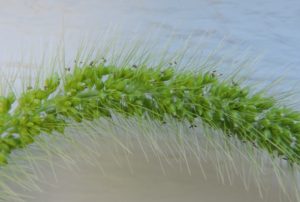
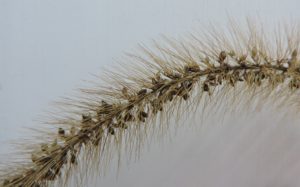
Leaf Description: Leaves alternate along the stem, and are about 15″ long (37 cm) and ¾” (2 cm) wide, light to medium green in color.
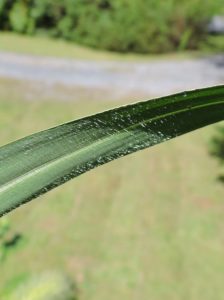
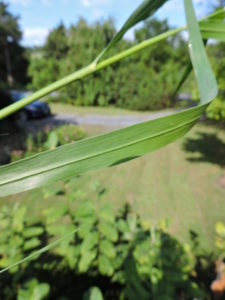
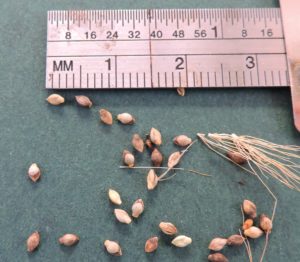
Seed Size: Seeds will develop inside at the base of the bristles along the central axis of the foxtail. Seeds are about 3/32 inch (2.5 mm) long, narrow and thin, flattened on one side, light beige/tan in color and darken to gray brown as they mature.
Harvest
| Jan | Feb | Mar | Apr | May | Jun | Jul | Aug | Sep | Oct | Nov | Dec | ||||||||||||||
|---|---|---|---|---|---|---|---|---|---|---|---|---|---|---|---|---|---|---|---|---|---|---|---|---|---|
| winter | winter | late winter | early spring | spring | late spring | early summer | summer | late summer | early fall | fall | late fall | ||||||||||||||
| seeds | x | x | x | x | x | x | |||||||||||||||||||
| greens | x | x | x | x | x | x | x | x | x | x | x | x | x | x | |||||||||||
Does this lend itself as a good enrichment item? Maybe, unless you are concerned about introducing it as a weed species onto the rehab property. Bristlegrass often grows in thick stands, so it is easy to cut bouquets of the grass with seed heads intact on the stems. If you are careful to avoid bouncing the plants around too much, the seed will stay intact on the seed head and you can offer the whole bouquet in a heavy container that will stay upright with the birds coming and going. Birds will perch on the stems and glean the seeds right off cut the plant to their hearts’ content.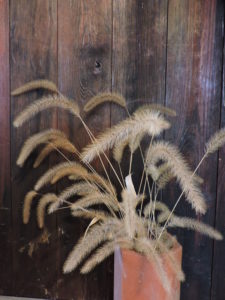
Harvesting Seed
Seed heads are at the top tip of the plant and arc over gracefully. You’ll have to examine the ‘foxtail” closely to see if the seed is mature, or to see if there is still seed in the head. The seeds are deep within the bristles, and run the full length against the center shaft on all sides. When immature, the seeds will be green or light in color. You want to harvest once the seeds have darkened to a dark gray-brown, but before they fall off. By winter, you’ll still see many foxtails blowing in the wind, but the seed will all be gone.
To harvest, bend the seed head over a large paper grocery sack and pull the foxtail through your hand. You may have to pull through a few times to dislodge as many seeds as possible or even use your fingertips to massage the seeds off. The seeds don’t pull off super easily, but should come off if the seed is mature. You can come back in a week and try again to pick up more seeds that have matured further.
There is not much further cleaning I do with the seed other than screen off extraneous plant bits that fell in my bag. Fortunately, the bristly parts of the seed head stay intact on the plant for the most part.
How to Store Prepared Seed:
Once cleaned and fully dried, choose a low humidity day—not a rainy day—to jar up your seed.
Glass or metal works best, because all plastics are somewhat porous to humidity. Canning jars and lids work well. Place seed in a tightly sealed, glass container and store in a dark, cool area for up to 1 year. Refrigeration and freezing work well. Label the airtight container with the seed name, date of harvest and which animals it should be used for.
If you intend to keep the seed longer than one year, jar up the seeds in two stages. First, jar the seeds up using a desiccant for up to 1 week. Then remove the desiccant and immediately repack the seed into an airtight container. Read more about drying seeds and using desiccants under the tab “Food Harvest, Process and Storage”
Keep stored seed in an airtight glass or metal container in a cool, dark place. Refrigeration and freezing works well, but allow container to warm to room temperature before opening. Discard any seed that ever appears moldy.
Harvesting Greens
Green leaves can be harvested at anytime spring to fall, but are tastier and less fibrous when young and short in late spring. Small plants might be pulled up whole after a rain. If so, by leaving the roots attached, the greens will stay fresher longer in the refrigerator, up to 1 week.
How to Store Prepared Greens: If you choose to, use a commercial vegetable cleaner or a ¼ cup (60ml) of vinegar added to wash water as a cleaner. Submerge the plant material and swish it around to remove all dirt from leaves and roots. Rinse in clean water. Always wash greens; you never know what might be on them…like animal feces or urine. Place in a colander or salad spinner to drain, then layout a towel and spread the greens on the towel and roll up the towel. Unroll and transfer the damp greens to storage. You may have to chop them to length to fit in a ziploc.
For storage, there are a couple of different possible container methods. If the greens will be used quickly within days, place the spun-and-towel-rolled damp greens to a 1 gallon zip-lock baggie with 12-15 holes cut in it to provide air and keep the greens from molding (or reuse commercial grape bags with holes). Label the bag with the plant name and which animals it should be used for. Keep container in the vegetable drawer of the refrigerator.
For storage longer than one week, use a rigid, lidded, airtight container. After washing and salad spinning the greens, place a paper towel in the bottom, then loosely fill with greens, but do not pack them in. Then lay a paper towel on top and put on lid. Keep container in the vegetable drawer of the refrigerator. Do not use if greens become moldy, slimy or dried out.
Many greens are very sensitive to exposure to ethylene gas, though greens themselves are low emitters of the gas. You may get longer quality by adding with a product that reduces free ethylene gas in the refrigerator. Greens are good until they become dry and crispy, fade in color, or become slimy or moldy.
Read more about storing leafy greens at “Food Harvest, Cleaning and Storage.”
Rare Species in Virginia
There are no threatened/ endangered bristlegrass species in Virginia.
Feed Bristlegrasses to:
bristlegrass | (Setaria spp.) | greens |
|---|---|---|
 Caution: One or more Setaria spp. has been toxic to horses and can create primary photosensitivity. Awns can cause mechanical damage to the mouth.(Burrows, G.E. & Tyrl, R.J., 2013) | ||
Cottontail, Eastern | Sylvilagus floridanus |
|
Muskrat, Common | Ondatra zibethicus |
|
bristlegrass | (Setaria spp.) | seeds |
 Caution: Awns of Setaria spp. can cause mechanical damage to the mouth.(Burrows, G.E. & Tyrl, R.J., 2013) | ||
Cottontail, Eastern | Sylvilagus floridanus |
|
Muskrat, Common | Ondatra zibethicus |
|
Blackbird, Red-winged | Agelaius phoeniceus | strong preference |
Blackbird, Rusty | Euphagus carolinus | strong preference |
Bobolink | Dolichonyx oryzivorus | strong preference |
Bunting, Snow | Plectrophenax nivalis | strong preference |
Cowbird, Brown-headed | Molothrus ater | strong preference |
Dickcissel | Spiza americana | strong preference |
Dove, Mourning | Zenaida macroura | strong preference |
Grosbeak, Blue | Guiraca caerulea | strong preference |
Junco, Dark-eyed | Junco hyemalis | strong preference |
Lark, Horned | Eremophila alpestris | strong preference |
Longspur, Lapland | Calcarius lapponicus | strong preference |
Sparrow, American Tree | Spizella arborea | strong preference |
Sparrow, Chipping | Spizella passerina | strong preference |
Sparrow, Lincoln's | Melospiza lincolnii | strong preference |
Sparrow, Song | Melospiza melodia | strong preference |
Towhee, Eastern | Pipilo erythrophthalmus | strong preference |
Bunting, Indigo | Passerina cyanea |
|
Cardinal, Northern | Cardinalis cardinalis |
|
Crossbill, Red | Loxia curvirostra |
|
Crossbill, White-winged | Loxia leucoptera |
|
Dove, Ground | Columbina passerina |
|
Grackle, Common | Quiscalus quiscula |
|
Meadowlark, Eastern | Sturnella magna |
|
Pipit, American | Anthus rubescens |
|
Redpoll, Common | Carduelis flammea |
|
Sparrow, Field | Spizella pusilla |
|
Sparrow, Fox | Passerella iliaca |
|
Sparrow, Grasshopper | Ammodramus savannarum |
|
Sparrow, Henslow's | Ammodramus henslowii |
|
Sparrow, House | Passer domesticus |
|
Sparrow, Savannah | Passerculus sandwichensis |
|
Sparrow, Vesper | Pooecetes gramineus |
|
Sparrow, White-crowned | Zonotrichia leucophrys |
|
Sparrow, White-throated | Zonotrichia albicollis |
|
Starling, European | Sturnus vulgaris |
|
Bobwhite, Northern | Colinus virginianus | strong preference |
Pheasant, Ring-necked | Phasianus colchicus |
|
Rail, King | Rallus elegans |
|
Rail, Yellow | Corturnicops noveboracensis |
|
Sandpiper, Pectoral | Calidris melanotos |
|
Snipe, Wilson | Gallinago delicata |
|
Teal, Blue-winged | Anas discors |
|
Teal, Green-winged | Anas crecca |
|
Turkey, Wild | Meleagris gallopavo |
|
Book References:
Burrows, G.E., Tyrl, R.J. (2013) Toxic Plants of North America, 2nd Edition, Oxford, U.K.: John Wiley & Sons, Inc.
Elpel, T.J. (2013) Botany in a Day (APG). Pony, Montana: Hops Press, LLC.
Martin, A.C., Zim, H.S., Nelson, A.L. (1951). American Wildlife and Plants: A Guide to Wildlife Food Habits. New York: Dover Publications.
Scott, M. (2013). Songbird Diet Index. National Wildlife Rehabilitators Association, St. Cloud, MN.
Weakly, A.S., Ludwig, J.C., & Townsend, J.F. (2012) Flora of Virginia. Fort Worth, Texas: Botanical Research Institute of Texas Press.
On-Line References:
USDA, NRCS. 2015. The PLANTS Database (http://plants.usda.gov, 4 February 2016). National Plant Data Team, Greensboro, NC 27401-4901 USA.
Virginia Botanical Associates. (Accessed February 2, 2016). Digital Atlas of the Virginia Flora (http://www.vaplantatlas.org). c/o Virginia Botanical Associates, Blacksburg.
